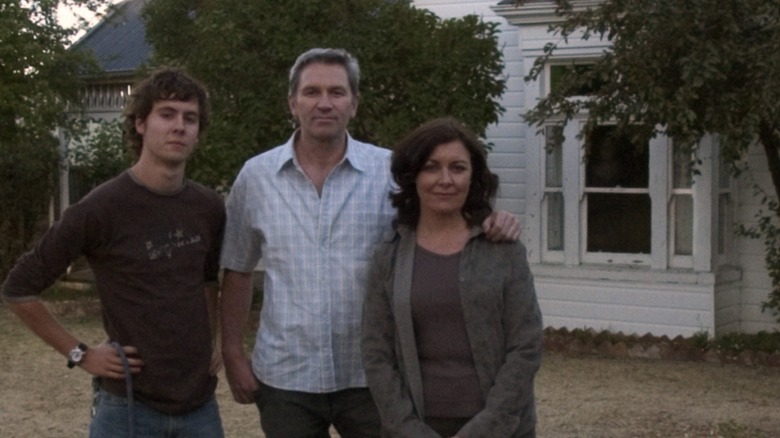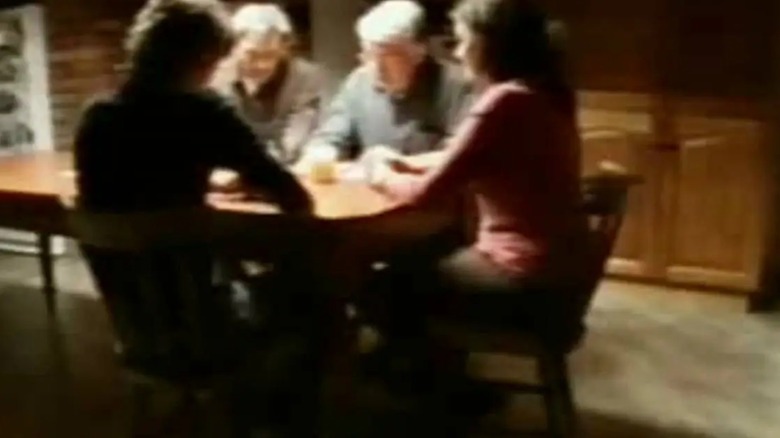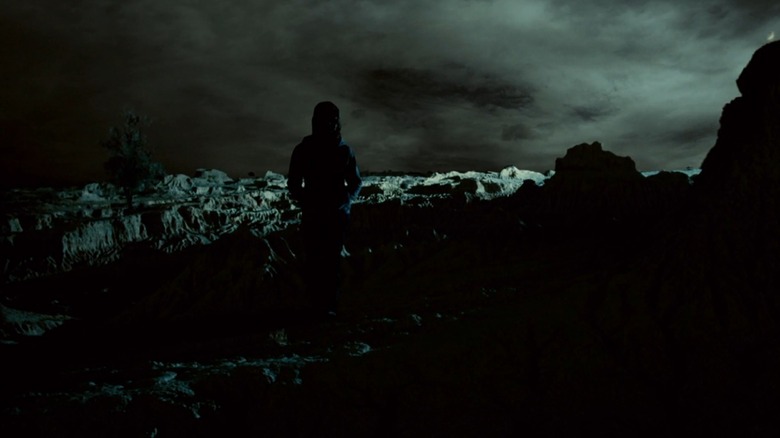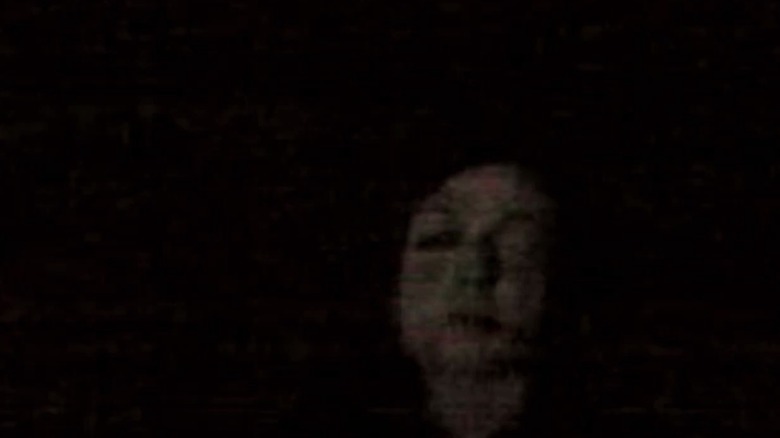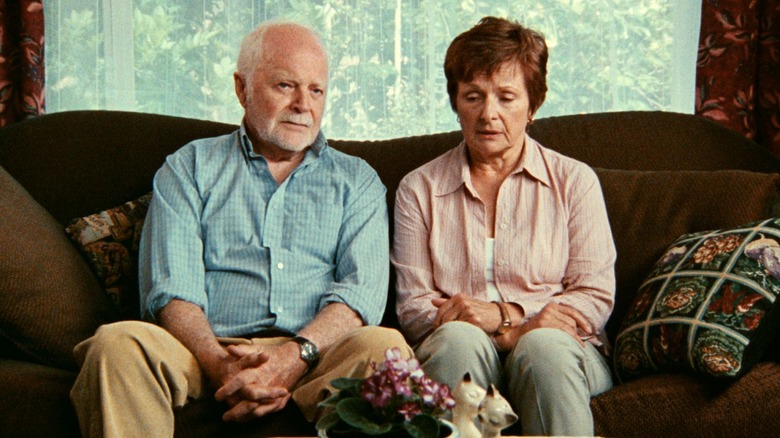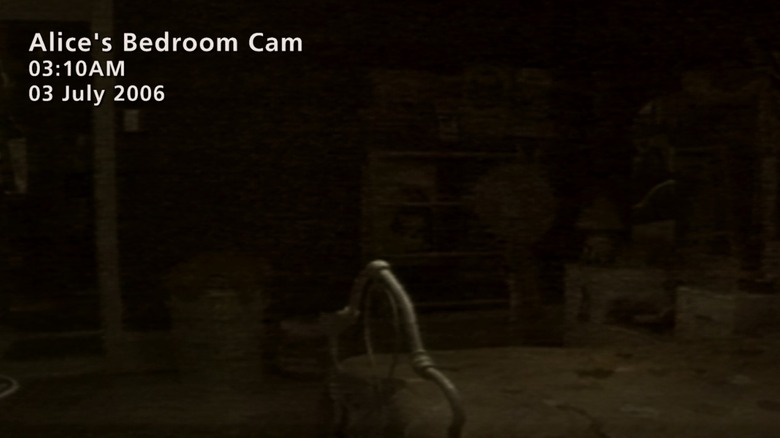Lake Mungo Ending Explained: The Spirit Of Grief Haunts On
Joel Anderson's "Lake Mungo" is one of the most enduring horror movies of the aughts. While the Australian documentary-style film started small — it was made on a shoestring budget and premiered at the Sydney Film Festival in 2008 — the reputation of "Lake Mungo" has only grown in the 15 years since its release. The movie is enigmatic and polarizing. While some horror fans see its mellowly presented talking-head interview structure as mundane, others call it one of the scariest movies of all time thanks to the creeping sense of dread that builds throughout the movie, culminating in a heart-pounding third-act reveal.
Both camps, though, seem to agree that there's more to "Lake Mungo" than meets the eye. The movie about a dead girl's family seeking closure after her drowning includes several clear-cut twists, but also a handful of points of ambiguity — and scenes that gesture towards interpretations of the movie that aren't at all explicitly telegraphed on screen. You can't throw a rock on horror-themed Reddit forums without finding a post about the end of "Lake Mungo." While out-there theories abound (the mom killed herself with the cords she was holding in one scene! The brother somehow hurt Alice!), there are also a few interpretations that hold water — as well as one that the director himself subscribes to.
What you need to remember about the plot of Lake Mungo
"Lake Mungo" is as a faux-documentary horror film about the death of a 16-year-old Australian girl named Alice (Talia Zucker). Early in the film, we learn that Alice drowned while swimming in a lake during a family trip, but images of her appear to be popping up on footage of the family home taken by her brother, Matthew (Martin Sharpe). While the doc is initially focused on the potential supernatural nature of the footage, it turns out Matthew faked appearances of Alice's ghost in order to try to bring closure to his deeply grieving mother.
In a twist, the cameras Matthew set up in the home also reveal the presence of an adult neighbor, Brett (Scott Terrill), going through Alice's things. Alice had worked for Brett and his wife as a babysitter, and it turns out they had been having an affair with her and filmed at least one sexual encounter — a tape Brett was looking for when he searched Alice's room.
The family also consults with a psychic, Ray (Steve Jodrell), who tells documentarians that before Alice died she had dreams of dying, and specifically of drowning. She also dreams of her mother being unable to see her, in what sounds like a description of a future moment in which she tries to communicate with her parents from the afterlife.
What happened at the end of Lake Mungo?
For the most part, "Lake Mungo" unfolds with an even-keeled tone that makes it feel much more like a real documentary than a typical horror movie. During its climax, though, all the realism pays off as it makes the film's scariest scene feel extra unnerving. When Alice's family finds out she buried her cell phone in the ground during a school trip to the titular Lake Mungo, they recover the phone and find something horrifying: on the trip, Alice came face to face with a doppelganger of herself, only this version of her was clearly dead from drowning. The corpse-Alice terrified her so much that the only way she could cope was by literally burying the evidence.
At the film's end, Alice's family express a sense of closure, and seem to think that Alice's spirit has told them everything it wanted them to know. They move out of the family home and begin to heal, but during the film's end credits, it's revealed that Alice's specter really was showing up in images taken at the house. We're left with eerie photos of Alice's seemingly unnoticed ghost, along with a post-credits scene that shows a shadowy figure at Lake Mungo, standing still while lightning flashes in time with a non-diegetic beeping sound.
Facing death
Regardless of the explanation for its supernatural elements, "Lake Mungo" is first and foremost about grief and mortality. When Alice sees herself dead, that literal experience is a fantastic metaphor for the persistence of depression and the sense of death's inevitability. Grief and death can be numbing, sure, but they can also shake a person awake in a negative way; once you come face to face with death for the first time, it can feel impossible to think about much else besides the fact that you, too, will die someday.
Once Alice gets the idea of dying into her head, her death becomes a sort of self-fulfilling prophecy that feels fated to her, following her around like an intrusive thought. Depression, it should be said, goes hand in hand with trauma, which Alice would certainly have plenty of after ending up in a sexual relationship with trusted adults in her life. "I feel like something bad is going to happen to me," she says at the beginning of the film, adding, "I feel like something bad has happened."
Her family's storyline also speaks to the film's ideas about loss and pain. They're initially unable to accept Alice's death, with her brother going to great lengths to pretend she's still around in order to try to bring the family closer. Their healing process only begins once they've learned more about her and confronted the unknown. It doesn't feel coincidental that the family's last name is "Palmer," which is shared by the enigmatic lost girl at the center of the surreal series "Twin Peaks." Alice is the family's own little girl lost, and they can only truly "find" her by accepting how much they didn't know about her when she was alive — and how unknowable the mysteries around her death will remain.
Ghosts and doppelgangers
Of course, there are also literal supernatural elements in the film. Its end credits paint a disturbing picture, indicating that Alice's spirit remained in the house even once her family decided that she must be at peace. This is a heartbreaking detail; her parents desperately want her to be at rest, yet her own worst nightmare — being trapped and invisible to them — actually came true.
Alice's doppelganger is another source of much speculation among fans of the movie. The most straightforward explanation for it is that of a literalized, corporeal premonition; she saw a vision of her own future, yet couldn't stop it from coming true. Reddit user thatzookzook shared my personal favorite theory on Alice's encounter with her double, and it's one that ties into Aboriginal mythology. According to this viewer, premonitions are a prominent part of Aboriginal folklore, and one popular ghost story involves a being that people encounter at night — one that makes them ill just by glimpsing its face.
According to scholar Philip A. Clarke's work "Indigenous Spirit and Ghost Folklore of 'Settled' Australia," water spirits called bunyip are thought to be dangerous for children who "strayed too close to the water's edge." Clarke also wrote that "some [Aboriginal] spirits are considered to be shape-shifters, and believed to take on the form of large or deformed people." While the Palmer family is not indigenous, the setting of Lake Mungo itself is certainly significant to Aboriginal Australians: it's actually the site of an archaeological find dubbed the Mungo Man, the oldest human remains ever found in Australia. When placed in the context of an ancient burial ground at the lake site — something Australian viewers of the film would likely be aware of — the events of "Lake Mungo" start to seem much less mysterious.
What has the cast and crew of Lake Mungo said about the ending?
Countless other theories about the finer details of "Lake Mungo" abound, but they may not line up with the filmmaker's intentions. Writer-director Anderson has gone on record (via an interview with John Catania reprinted on After Dark Films' Facebook page) saying, "I don't think it's a supernatural thriller." Instead, he says, "It's a way of exploring a lot of things about what is important to people, how people deal with the unthinkable happening, how people deal with grief, and how things are senseless." Anderson points out that the way most people approach an unthinkable tragedy is often not logical or intellectual. The documentary format of "Lake Mungo" allowed for an impressionistic exploration of how each person in the family dealt with the loss, trying to make sense of an event that can't be made sense of.
Though Anderson's comments don't explain why Alice appeared like a ghost in photos at the end of the movie, he does mention how the archival elements of the film play into its characters' subjective, grief-tinted ideas about her. He said:
"In a way those images of Alice that come, the images in photograph and video that there's no rational explanation for, they are like the last home movies of her. So, in lots of ways I'm really interested in how our sense of what is real, our sense of how we remember things, is videoed through technology."
While "Lake Mungo" remains mysterious, its most jarring moment is universal: a rattling confrontation with death, something that very few of us want to look in the face until we have to.
